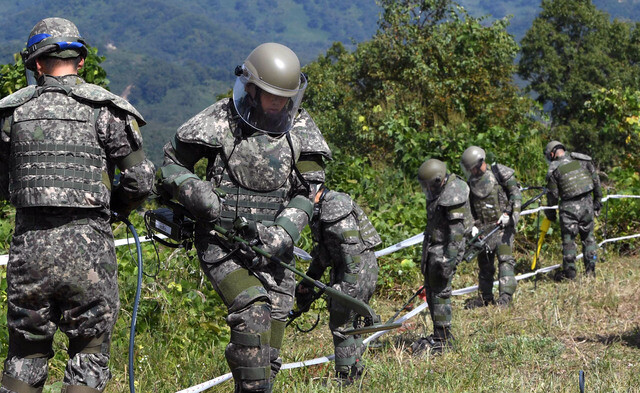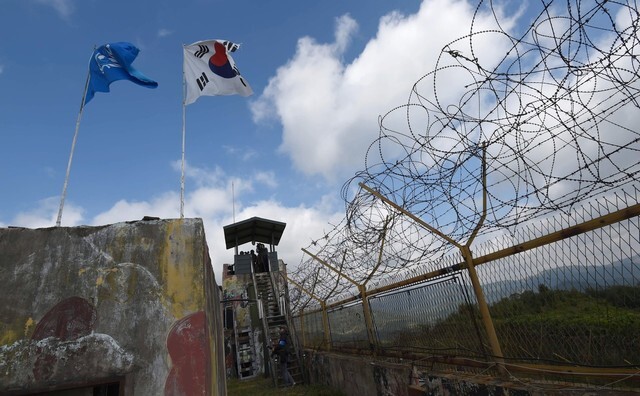hankyoreh
Links to other country sites 다른 나라 사이트 링크
[Reportage] Joint mine removal operation begins in DMZ

It was the morning of Oct. 2, the day after South and North Korea began their full-scale effort to exhume the remains of troops from the Korean War. Within the Demilitarized Zone (DMZ) in Daema, a village in Cheorwon County, Gangwon Province, where the ridge runs north from the summit of “Arrowhead (Hwasalmeori) Hill,” seven soldiers fitted with heavy-duty mine detection equipment stood side by side searching throughout the surrounding earth.
At the very front, a soldier holding a Schonstedt mine detector carefully prodded through the surrounding soil, after which another soldier holding a brush cutter just behind would cut the profuse grass to ensure a sightline. Further back were two mine detector operators, one air compressor operator, and another mine detector operator following behind. Once any suspected mines were detected, they would simply leave an indicator, with a separate explosive handling team to come later for confirmation and removal of mines.
Schonstedt equipment is capable of detecting metals at depths of up to three meters underground. “The drawback to the Schonstedt is that you can’t detect M14 anti-personnel mines,” explained the local unit commander.

“So we do the initial detection with the Schonstedt, and then we do two or three more detections using mine detectors with different sensitivity settings.” Known colloquially as “ankle mines,” M14 anti-personnel mines are made from plastic and do not respond to metal detectors. Compressed air is used to blow a powerful blast of air to ensure safe visibility around suspected mines.
I heard that three security soldiers fully armed with K-1 or K-2 rifles were positioned ahead of the advancing mine detection team just in case, but they were not visible behind the ridge. Behind the team, three other security soldiers armed with rifles could be seen standing guard.
On Oct. 2, military authorities informed the press for the first time about mine removal efforts under way on Arrowhead Hill in the DMZ. Past Gate 57 under the jurisdiction of the 5th Infantry Division, a guard post stood like a concrete fortress on Arrowhead Hill. Looking along the northern ridge, I could easily see the North Korean guard post on the other side of the mountain. I could truly sense that this was the very front line of the inter-Korean confrontation.
Although it was a very risky mine removal effort, there was no sense of tension – just the constant whirring of the compressor pump motor pounding against my eardrums. Instead, it merely seemed peaceful and comfortable with the warm autumn sunshine and the surrounding greenery. It felt strange.
Historic and strategic significance of Arrowhead Hill
Arrowhead Hill was chosen by South and North Korea for their joint excavation of remains because of its symbolism. Standing 281 meters above sea level, it is a relatively small hill, roughly equal in height to Namsan in Seoul (270.9 meters). But from its heights that day, I could see the full broad sprawl of Cheorwon Plain to the south. I nodded along as the local unit official explained to me that this was a key strategic point, where Cheorwon Plain would be in jeopardy if it were occupied by the enemy.
It is because of this strategic importance that Arrowhead Hill and White Horse (Baengma) Hill to the east (395 meters above sea level) were the sites of closely contested battles between South and North during the Korean War. In the summer of 1953, just before the Armistice Agreement, not only South Korean forces but also troops from the US, France, and China fought in the battle for Arrowhead Hill. Military authorities believe the remains of over 200 South Korean troops and over 100 US and French troops remain buried on the hill.
Because of the fierce battle for Arrowhead Hill, the surrounding area is dotted with landmines and unexploded bombs. Posing threats to human safety, the mines and bombs will have to be removed before the joint inter-Korean excavation effort can proceed.
“This is not a case where [mines] were laid according to plan. It is an area with many unconfirmed mines placed by our forces and the enemy to hinder each other,” the local unit commander said.
“We have no way of knowing how many of them are buried or where, so we have to check for each one.”
The Arrowhead Hill mine removal effort is taking place at two locations. One is near the reconnaissance route used by soldiers for monitoring of the DMZ. Mines are to be removed over a four-meter stretch along 800 meters of the route leading to Arrowhead Hill’s northern ridge (an area of 800 meters by 4 meters).
“At the moment, about one to two meters of the scouting route can be safely used. You can see [what we’re doing] as broadening that width to four meters,” the local unit commander said.
Mines are also being cleared from around a trench below the mountain. The target area is a 500-meter section of the trench to be cleared to a width of 10 meters (500 x 10 meters).
“We’ve been making a lot of preparations for this effort over the past three months, including reconnaissance to familiarize ourselves with the terrain,” the local unit commander said.
“Safety issues are a paramount concern in carrying out the operation.”
Gravity and scale of mine removal operation
Eighty mine removal engineers are taking part in the effort. All are experienced veterans who have worked in mine removal for at least one year; 40 percent of the assigned staff are reportedly non-commissioned officers. The effort is to be carried out for four hours a day: two hours in the morning and two in the afternoon. The staff wear over 20kg of equipment while working, including safety uniforms, mine boots and overshoes, helmets, bulletproof vests, and pads. The work has been described as quite strenuous.
“It’s very difficult work, so they typically work for about 10 to 15 minutes before switching with another team,” a military official said.
The engineers are not the only ones taking part in the mine removal. A 13-member excavation task force is on standby in case any remains turn up during the removal, while a four-member explosive ordnance disposal (EOD) team also remains on permanent standby along with a four-member medical team including army surgeons in case of a safety accidents. Further assisting the mine removal is a guard team including 24 members of four groups associated with the 5th Infantry Division’s reconnaissance battalion.

“We’re planning to finish the mine removal by November. It’s difficult to dig in the ground during winter, so the remains exhumation is supposed to start next April,” the local unit commander said.
Work on roads for joint exhumation efforts to begin after mine removal
Army authorities also plan to begin work establishing roads to ensure access to sites where joint exhumation efforts are to take place. The new road is to measure 12 meters across and 1.7km in length, extending from the Bima Bridge across Yeokgok Stream in the DMZ along the foothills east of Arrowhead Hill to the Military Demarcation Line (MDL). The only visible indication during the media event on Oct. 2 was a red flag marking the area near Bima Bridge where the road is to begin.
Inter-Korean road construction is also to take place once the mines have been cleared. For the mine clearing, an excavator is used first, after which the mine detection team is sent in.
“We have a bulletproof excavator doing the digging, with netting that serves as a sorting bucket to catch the mines,” the local unit commander explained. “If any mines are buried there, most of them will be filtered out by the excavator’s sorting bucket.” Thirty engineers are taking part in the removal, assisted by members of the excavation task force, medical team, EOD team, and guard team. The road building effort is also scheduled for completion by the end of the year.
South and North Korea agreed to begin individual mine removal and road building efforts in their respective regions on Oct. 1. For that reason, the North is believed to have also begun its own mine removal work.
“The gateway region leading into the DMZ in the North is obscured by the mountainous terrain, so we can’t see it from here,” the local unit commander said. “The North is believed to have also started work, but we haven’t verified anything visually.”
By Park Byong-su, senior staff writer
Please direct comments or questions to [english@hani.co.kr]

Editorial・opinion
![[Column] Has Korea, too, crossed the Rubicon on China? [Column] Has Korea, too, crossed the Rubicon on China?](https://flexible.img.hani.co.kr/flexible/normal/500/300/imgdb/original/2024/0419/9317135153409185.jpg) [Column] Has Korea, too, crossed the Rubicon on China?
[Column] Has Korea, too, crossed the Rubicon on China?![[Correspondent’s column] In Japan’s alliance with US, echoes of its past alliances with UK [Correspondent’s column] In Japan’s alliance with US, echoes of its past alliances with UK](https://flexible.img.hani.co.kr/flexible/normal/500/300/imgdb/original/2024/0419/2317135166563519.jpg) [Correspondent’s column] In Japan’s alliance with US, echoes of its past alliances with UK
[Correspondent’s column] In Japan’s alliance with US, echoes of its past alliances with UK- [Editorial] Does Yoon think the Korean public is wrong?
- [Editorial] As it bolsters its alliance with US, Japan must be accountable for past
- [Guest essay] Amending the Constitution is Yoon’s key to leaving office in public’s good graces
- [Editorial] 10 years on, lessons of Sewol tragedy must never be forgotten
- [Column] A death blow to Korea’s prosecutor politics
- [Correspondent’s column] The US and the end of Japanese pacifism
- [Guest essay] How Korea turned its trainee doctors into monsters
- [Guest essay] As someone who helped forge Seoul-Moscow ties, their status today troubles me
Most viewed articles
- 1[Column] The clock is ticking for Korea’s first lady
- 2[Correspondent’s column] In Japan’s alliance with US, echoes of its past alliances with UK
- 3After 2 months of delayed, denied medical care, Koreans worry worst may be yet to come
- 4[Column] Has Korea, too, crossed the Rubicon on China?
- 5[Editorial] When the choice is kids or career, Korea will never overcome birth rate woes
- 6Samsung barricades office as unionized workers strike for better conditions
- 7US exploring options for monitoring N. Korean sanctions beyond UN, says envoy
- 8US overtakes China as Korea’s top export market, prompting trade sanction jitters
- 9[Photo] Smile ambassador, you’re on camera
- 10Hong Se-hwa, voice for tolerance whose memoir of exile touched a chord, dies at 76